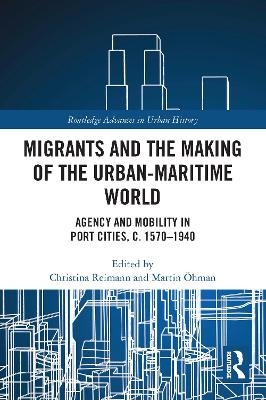
Migrants and the Making of the Urban-Maritime World
Routledge (Verlag)
978-0-367-54362-4 (ISBN)
This volume explores the mutually transformative relations between migrants and port cities. Throughout the ages of sail and steam, port cities served as nodes of long-distance transmissions and exchanges. Commercial goods, people, animals, seeds, bacteria and viruses; technological and scientific knowledge and fashions all arrived in, and moved through, these microcosms of the global. Migrants made vital contributions to the construction of the urban-maritime world in terms of the built environment, the particular sociocultural milieu, and contemporary representations of these spaces. Port cities, in turn, conditioned the lives of these mobile people, be they seafarers, traders, passers-through, or people in search of a new home. By focusing on migrants—their actions and how they were acted upon—the authors seek to capture the contradictions and complexities that characterized port cities: mobility and immobility, acceptance and rejection, nationalism and cosmopolitanism, diversity and homogeneity, segregation and interaction.
The book offers a wide geographical perspective, covering port cities on three continents. Its chapters deal with agency in a widened sense, considering the activities of individuals and collectives as well as the decisive impact of sailing and steamboats, trains, the built environment, goods or microbes in shaping urban-maritime spaces.
Christina Reimann is a researcher at Stockholm University and at Södertörn University. Martin Öhman is a researcher at Gothenburg University.
Introduction Part 1: Migrants and the Construction of Port City Spaces 1. Migrant Agencies in the Early Modern Manila Bay 2. Space, Representation and Practice in the Formation of Izmir During the Long Nineteenth Century 3. "Let Genius and Patriotism, from Whatever Quarter of the Earth, Be Naturalized among Us": New York City Friends of Industry and Foreign Migrants, c. 1815–1842 4. Foreign Sailors and Working-Class Communities: Race, Crime and Moral Panics in London’s Sailortown, 1880–1914 5. The "Greatest Traveller of Them All": Rats, Port Cities, and the Plague in U.S. Imperial History (c. 1899–1915) Part 2: Urban-Maritime Space and Migrant Experiences 6. "You Cannot Pass": The Reception and Rejection of a Stranger in Helsingborg, 1744 7. The Transit Stage as a Migratory Experience: The Syrians in Marseille (1880–1920) 8. Migration, Maritime Labor, and Family: The Life Course of Carel Hendrik Bloebaum, 1848–1916 9. Foreign Female Sex Workers in an Atlantic Port City: Elite Prostitution in Late Nineteenth-Century Antwerp 10. Entangling the Past and the Present: The Place of Port Cities in Self-Narratives of German-Speaking Forty-Eighters 11. Labor Mobility and Migrations in the Barcelona Docks, c. 1900–1950 Epilogue: What Do Histories of Migration Tell Us About Port Cities?
| Erscheinungsdatum | 13.07.2022 |
|---|---|
| Reihe/Serie | Routledge Advances in Urban History |
| Zusatzinfo | 3 Tables, black and white; 2 Line drawings, black and white; 14 Halftones, black and white; 16 Illustrations, black and white |
| Verlagsort | London |
| Sprache | englisch |
| Maße | 152 x 229 mm |
| Gewicht | 435 g |
| Themenwelt | Geisteswissenschaften ► Geschichte ► Allgemeine Geschichte |
| Geschichte ► Teilgebiete der Geschichte ► Kulturgeschichte | |
| Geschichte ► Teilgebiete der Geschichte ► Wirtschaftsgeschichte | |
| ISBN-10 | 0-367-54362-1 / 0367543621 |
| ISBN-13 | 978-0-367-54362-4 / 9780367543624 |
| Zustand | Neuware |
| Haben Sie eine Frage zum Produkt? |
aus dem Bereich


